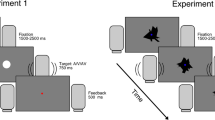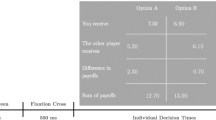Abstract
The demonstration that human decision-making can systematically violate the laws of rationality has had a wide impact on behavioural sciences. In this study, we use a pupillary index to adjudicate between two existing hypotheses about how irrational biases emerge: the hypothesis that biases result from fast, effortless processing and the hypothesis that biases result from more extensive integration. While effortless processing is associated with smaller pupillary responses, more extensive integration is associated with larger pupillary responses. Thus, we tested the relationship between pupil response and choice behaviour on six different foundational decision-making tasks that are classically used to demonstrate irrational biases. Participants demonstrated the expected systematic biases and their pupillary measurements satisfied pre-specified quality checks. Planned analyses returned inconclusive results, but exploratory examination of the data revealed an association between high pupillary responses and biased decisions. The findings provide preliminary support for the hypothesis that biases arise from gradual information integration.
Protocol registration
The stage 1 protocol for this Registered Report was accepted in principle on 19 December 2018. The protocol, as accepted by the journal, can be found at https://doi.org/10.6084/m9.figshare.c.4368452.v1.
This is a preview of subscription content, access via your institution
Access options
Access Nature and 54 other Nature Portfolio journals
Get Nature+, our best-value online-access subscription
$29.99 / 30 days
cancel any time
Subscribe to this journal
Receive 12 digital issues and online access to articles
$119.00 per year
only $9.92 per issue
Buy this article
- Purchase on Springer Link
- Instant access to full article PDF
Prices may be subject to local taxes which are calculated during checkout



Similar content being viewed by others
Data availability
The data that support the findings of this study have been deposited on the Open Science Framework and are publicly available at https://osf.io/sygz3/.
Code availability
The custom scripts used for this study have been deposited on the Open Science Framework and are publicly available at https://osf.io/sygz3/.
References
Tversky, A. & Kahneman, D. The framing of decisions and the psychology of choice. Science 211, 453–458 (1981).
Kahneman, D. Maps of bounded rationality: psychology for behavioral economics. Am. Econ. Rev. 93, 1449–1475 (2003).
Fiske, S. T. & Taylor, S. E. Social Cognition: From Brains to Culture (Sage, 2013).
Usher, M., Tsetsos, K., Erica, C. Y. & Lagnado, D. A. Dynamics of decision-making: from evidence accumulation to preference and belief. Front. Psychol. 4, 758 (2013).
Busemeyer, J. R., Jessup, R. K., Johnson, J. G. & Townsend, J. T. Building bridges between neural models and complex decision making behaviour. Neural Netw. 19, 1047–1058 (2006).
Krajbich, I. & Rangel, A. Multialternative drift diffusion model predicts the relationship between visual fixations and choice in value-based decisions. Proc. Natl Acad. Sci. USA 108, 13852–13857 (2011).
Usher, M. & McClelland, J. L.Loss aversion and inhibition in dynamical models of multialternative choice. Psychol. Rev. 111, 757–769 (2004).
Busemeyer, J. R. & Townsend, J. T.Decision field theory: a dynamic-cognitive approach to decision making in an uncertain environment. Psychol. Rev. 100, 432–459 (1993).
Diederich, A. Dynamic stochastic models for decision making under time constraints. J. Math. Psychol. 41, 260–274 (1997).
Roe, R. M., Busemeyer, J. R. & Townsend, J. T. Multialternative decision field theory: a dynamic connectionst model of decision making. Psychol. Rev. 108, 370–392 (2001).
Johnson, J. G. & Busemeyer, J. R.A dynamic, stochastic, computational model of preference reversal phenomena. Psychol. Rev. 112, 841–861 (2005).
Kahneman, D. Attention and Effort (Prentice-Hall, 1973).
Eldar, E., Cohen, J. D. & Niv, Y. The effects of neural gain on attention and learning. Nat. Neurosci. 16, 1146–1153 (2013).
Eldar, E., Niv, Y. & Cohen, J. D. Do you see the forest or the tree? Neural gain and breadth versus focus in perceptual processing. Psychol. Sci. 27, 1632–1643 (2016).
Eldar, E., Cohen, J. D. & Niv, Y. Amplified selectivity in cognitive processing implements the neural gain model of norepinephrine function. Behav. Brain Sci. 39, e206 (2016).
Joshi, S., Li, Y., Kalwani, R. M. & Gold, J. I. Relationships between pupil diameter and neuronal activity in the locus coeruleus, colliculi, and cingulate cortex. Neuron 89, 221–234 (2016).
Servan-Schreiber, D., Printz, H. & Cohen, J. D. A network model of catecholamine effects: gain, signal-to-noise ratio, and behavior. Science 249, 892–895 (1990).
Aston-Jones, G. & Cohen, J. D. An integrative theory of locus coeruleus–norepinephrine function: adaptive gain and optimal performance. Annu. Rev. Neurosci. 28, 403–450 (2005).
Murphy, P. R., Robertson, I. H., Balsters, J. H. & O’Connell, R. G. Pupillometry and P3 index the locus coeruleus–noradrenergic arousal function in humans. Psychophysiol 48, 1532–1543 (2011).
Gilzenrat, M. S., Nieuwenhuis, S., Jepma, M. & Cohen, J. D. Pupil diameter tracks changes in control state predicted by the adaptive gain theory of locus coeruleus function. Cogn. Affect. Behav. Neurosci. 10, 252–269 (2010).
Kahneman, D. Thinking, Fast and Slow (Macmillan, 2011).
Camerer, C. F. & Hogarth, R. M. The effects of financial incentives in experiments: a review and capital–labor–production framework. J. Risk Uncertain. 19, 7–42 (1999).
De Gee, J. W., Knapen, T. & Donner, T. H. Decision-related pupil dilation reflects upcoming choice and individual bias. Proc. Natl Acad. Sci. USA 111, E618–E625 (2014).
Urai, A. E., Braun, A. & Donner, T. H. Pupil-linked arousal is driven by decision uncertainty and alters serial choice bias. Nat. Commun. 8, 14637 (2017).
De Gee, J. W. et al. Dynamic modulation of decision biases by brainstem arousal systems. eLife 6, e23232 (2017).
De Gee, J. W. et al. Pupil-linked phasic arousal predicts a reduction of choice bias across species and decision domains. eLife 9, e54014 (2020).
Reas, C. & Fry, B. Processing: a Programming Handbook for Visual Designers and Artists (MIT Press, 2007).
Lambert, A., Wells, I. & Kean, M. Do isoluminant color changes capture attention? Atten. Percept. Psychophys. 65, 495–507 (2003).
Brainard, D. H. The psychophysics toolbox. Spat. Vis. 10, 433–436 (1997).
Tversky, A. & Kahneman, D. Judgment under uncertainty: heuristics and biases. Science 185, 1124–1131 (1974).
Jacowitz, K. E. & Kahneman, D. Measures of anchoring in estimation tasks. Pers. Soc. Psychol. Bull. 21, 1161–1166 (1995).
Peterson, C. R. & DuCharme, W. M.A primacy effect in subjective probability revision. J. Exp. Psychol. 73, 61–65 (1967).
Levin, I. P., Johnson, R. D., Russo, C. P. & Deldin, P. J. Framing effects in judgment tasks with varying amounts of information. Organ. Behav. Hum. Decis. Process. 36, 362–377 (1985).
Van Schie, E. C. & Van Der Pligt, J. Influencing risk preference in decision making: the effects of framing and salience. Organ. Behav. Hum. Decis. Process. 63, 264–275 (1995).
Kahneman, D. & Tversky, A. Prospect theory: an analysis of decision under risk. Econometrica 47, 263–292 (2013).
Shafir, E. Choosing versus rejecting: why some options are both better and worse than others. Mem. Cogn. 21, 546–556 (1993).
Griffin, D. & Tversky, A. The weighing of evidence and the determinants of confidence. Cogn. Psychol. 24, 411–435 (1992).
Bishop, C. M. Pattern Recognition and Machine Learning (Springer, 2006).
Carpenter, B. et al. Stan: a probabilistic programming language. J. Stat. Softw. 76, 1–32 (2017).
Kruschke, J. Doing Bayesian Data Analysis: A Tutorial With R, JAGS, and Stan (Academic Press, 2014).
Bates, D. et al. Package ‘lme4’. Convergence 12, 2 (2015).
Acknowledgements
This project was made possible through grants from the Israel Science Foundation (grant No. 1094/20; to E.E.), Army Research Office (grant No. W911NF-14-1-0101; to Y.N.) and Templeton Foundation (to V.F., J.D.C. and Y.N.). The funders had no role in study design, data collection and analysis, decision to publish or preparation of the manuscript.
Author information
Authors and Affiliations
Contributions
E.E. conceived of the study. E.E., V.F., J.D.C. and Y.N. developed the methodology. E.E. and V.F. performed the investigations. E.E. and V.F. wrote the original draft of the manuscript. E.E., V.F., J.D.C. and Y.N. reviewed and edited the manuscript. Y.N. acquired funding. J.D.C. and Y.N. supervised the study.
Corresponding author
Ethics declarations
Competing interests
The authors declare no competing interests.
Additional information
Publisher’s note Springer Nature remains neutral with regard to jurisdictional claims in published maps and institutional affiliations.
Peer review information Nature Human Behaviour thanks Christopher Chambers, Joshua Gold, Peter Murphy and Konstantinos Tsetsos for their contribution to the peer review of this work. Primary Handling Editor: Marike Schiffer.
Supplementary information
Supplementary Information
Supplementary Discussion, Supplementary Figs. 1–4, Supplementary Table 1 and Supplementary References.
Rights and permissions
About this article
Cite this article
Eldar, E., Felso, V., Cohen, J.D. et al. A pupillary index of susceptibility to decision biases. Nat Hum Behav 5, 653–662 (2021). https://doi.org/10.1038/s41562-020-01006-3
Received:
Accepted:
Published:
Issue Date:
DOI: https://doi.org/10.1038/s41562-020-01006-3



